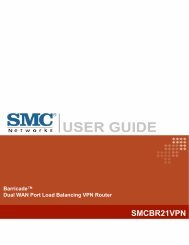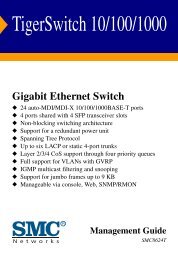Voice over IP Solutions (VoIP) - SMC
Voice over IP Solutions (VoIP) - SMC
Voice over IP Solutions (VoIP) - SMC
You also want an ePaper? Increase the reach of your titles
YUMPU automatically turns print PDFs into web optimized ePapers that Google loves.
Signaling Protocols<br />
S<strong>IP</strong> Introduction<br />
Signaling,<br />
Call control<br />
S<strong>IP</strong><br />
Media transport,<br />
Payload<br />
Audio, Video<br />
Codecs<br />
RTP<br />
TCP UDP<br />
<strong>IP</strong><br />
Quality of Service<br />
RTCP RSVP<br />
A-VO<strong>IP</strong>-15<br />
The Sesssion Initiation Protocol (S<strong>IP</strong>) is a relatively new Internet<br />
standard that basically is a simple signaling and application layer control<br />
protocol for multimedia conferencing and telephony. It is today besides<br />
H.323 the most important standard for <strong>IP</strong> / Internet voice applications.<br />
S<strong>IP</strong> is defined in RFC 2543, as part of the MMUSIC (Multiparty<br />
Multimedia Session Control) working group of the IETF. This group is<br />
working on a complete framework of protocols to solve abroad range of<br />
multimedia conferencing and communication solutions. These include SDP<br />
(Session Description Protocol), SAP (Session Announcement Protocol),<br />
RTSP (Real-Time Stream Protocol), SCCP (Simple Conference Control<br />
Protocol) and S<strong>IP</strong>.<br />
S<strong>IP</strong> is a simple, low-level protocol for establishing, modifying or terminating<br />
multimedia sessions or Internet telephony calls between two or more users.<br />
Such sessions can include voice, video, chat, other multimedia data (such<br />
as interactive games).The protocol can also invite participants to unicast or<br />
multicast sessions.<br />
S<strong>IP</strong> supports name mapping and redirection services. This makes it<br />
possible to identify users regardless where they are and allows users to<br />
initiate and receive connections and services from any location.<br />
S<strong>IP</strong> is a simple request-response protocol, dealing with requests from<br />
clients and responses from servers. Users are identified by S<strong>IP</strong> URLs. S<strong>IP</strong><br />
determines the end system to be used for the session, the communication<br />
media and media parameters. It then initiates the communication. It<br />
establishes call parameters at each end of the communication, and handles<br />
call transfer and termination. Like H.323 S<strong>IP</strong> uses the RTP (Real-Time<br />
Transport Protocol) for transporting the voice (multimedia) information.<br />
15

















